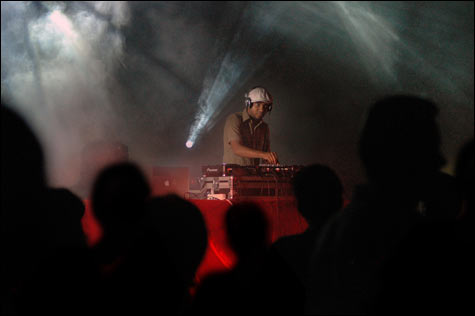
TRAVELING SOUNDS: Spooky’s world has expanded from the East Village to encompass the South Pole.
|
WFNX’s Jazz Brunch Top Five
1. Eliane Elias, Something for You [Blue Note]
2. Herbie Hancock, River: The Joni Letters [Verve]
3. Alfredo Naranjo, Y El Guajeo [Cacao Music]
4. Changuito, Telegrafia Sin Hilo [Cacao Music]
5. Harlem Experiment, The Harlem Experiment [Ropeadope]
|
When I get DJ Spooky on the phone a week ago Tuesday, he’s fresh home in New York City from Antarctica. He’s been working on Terra Nova: The Antarctica Suite, a film/multimedia performance he’ll be presenting at the Sundance Film Festival at the end of the month in its program of digital films. This is a part of his current interest in “applying DJ technique to film,” using the traditions of montage to extend his own ideas of collage and juxtaposition. “The way culture is working these days, I really feel like the city as we know it, the way music is made, has become the defining way of thinking about culture right now. I want to figure out some other way to get out of the city altogether. For this specific project — this is the most remote place I’ve ever been.”
It’s also indicative of this artist’s ever-expanding vision. Spooky (a/k/a Paul D. Miller) comes to the ICA next week in three guises — as lecturer talking about the ideas from his 2004 MIT Press book Rhythm Science (undoubtedly with multimedia aids), as headliner for a multi-DJ night, and as concert artist performing his “Subliminal Strings” with a chamber orchestra. Spooky emerged from the Brooklyn and Lower East Side alternative-DJ scene of the mid ’90s, playing parties and releasing CDs that featured his “illbient” æsthetic — a term he coined to describe a more urban take on Eno-esque ambiance. Here were the same slowly morphing soundscapes familiar from Eno’s work (or even from the extended drum ’n’ bass tracks of folks like BT), but with an urban edge: the sounds of clacking subway doppelgänger, snatches of hip-hop rhythms. At the same time, it was often a more chill æsthetic than the downtown dance-club or rock-club scene: no beat-heavy house music, and none of the social exclusivity that went with it, the guest lists and the velvet ropes. The illbient scene was about come-as-you-are and bring-what-you-want.
“The idea was to have no idea,” Spooky told me in 1996, “You never knew who was going to show up or who was going to do what. Our scene grew up in the East Village, mainly because it was word-of-mouth and it was idealistic. We tried to get rid of the barriers between stuff.” Illbient, unlike Eno, “wasn’t a withdrawal from the urban landscape,” but “an immersion in it.”
For Spooky, modern culture is DJ culture, and the mix is its operative metaphor: music is just information, divorced from context, individual sounds as signifiers. It’s the kind of decontextualization that can drive some listeners (okay: me) crazy, especially when a beloved performance by a great artist like Billie Holiday is remixed to oblivion — a document of lived time obliterated in modern beats and edits.
But Spooky, drawn as he is to what sounds good, doesn’t simply mix sounds for their own sake. A former double major (French literature and philosophy) at Bowdoin College, he deconstructs in order to build new narratives, and some of his best early illbient work unfolded like dreamscapes (his full handle is “DJ Spooky That Subliminal Kid”). Rhythm Science is part manifesto and part autobiography. Its accompanying CD is an anthology of mixes drawn from the Sub Rosa catalogue — spoken-word and music that include Luciano Berio, Seefeel, Bill Laswell, William S. Burroughs, Brion Gysin, and Patti Smith.
But as up-to-the-minute as Spooky is, his selections are obsessed with the past, especially with the early-20th-century avant-garde. Against the whoosh and scrape of DJ beats, amid pattering drum ’n’ bass or sputtering tablas, are recitations by James Joyce (“Anna Livia Plurabelle”), Gertrude Stein (her Picasso “portrait”), and dadaist Kurt Schwitters comically rolling his r’s in German, like a proto drum ’n’ bass vocal. These mysterious voices from the past emerge from the mixes like recovered memories, a collective cultural unconscious. When out of this dreamy mix, more than halfway through the disc, a scratchy piano recording of Debussy’s lyrical, evocative “D’un cahier d’esquisses” surfaces, unadorned by DJ tricks, the result is almost unbearably poignant — the unambiguous, unrecoverable past. The track ID indicates that it’s Debussy himself at the piano.
Spooky’s most celebrated recent investigation of history was Rebirth of a Nation, his 75-minute remix and “digital exorcism” of D.W. Griffith’s controversial three-hour 1915 Civil War epic The Birth of a Nation. Performing it live at Sanders Theatre in March 2005, Spooky digitally re-edited the film, mixing images from a Bill T. Jones dance performance as well as rejiggering the original montage. Fresh off the 2000 and 2004 elections, he was drawn to the idea of “competing stories, competing narratives” in a media-saturated world. “I’m trying to think of DJing as media literacy — how to read these bizarre signs of the urban landscape as it becomes more and more digital,” he told me shortly before the Sanders performance. (A DVD version of Rebirth is scheduled for release from Starz Media.)